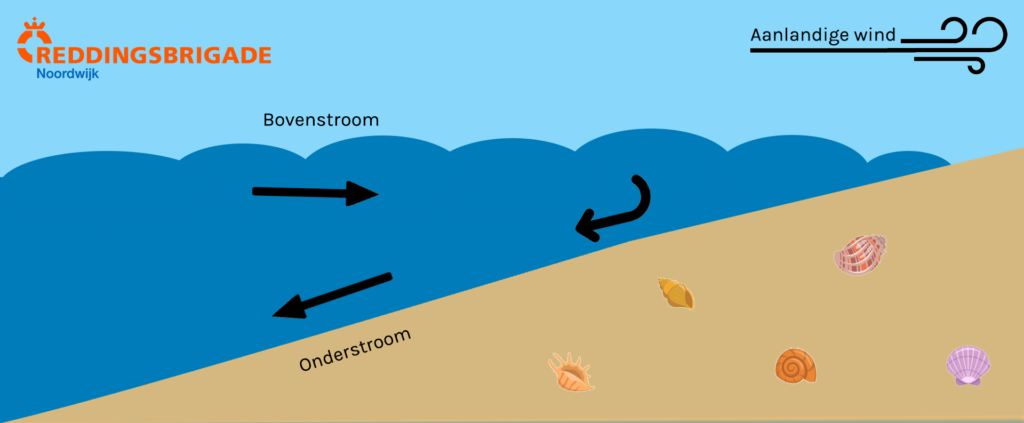Reddingsbrigade Noordwijk gets into action a lot every year to save people from dangerous situations. By explaining the dangers of the sea, many dangerous situations can be prevented. Preventing drowning accidents by providing information is an important task for the lifeguard.
The situation at sea is changeable and therefore dangerous by definition. Therefore, do not go too deep into the sea if you are not used to swimming or are not familiar with the sea.
What To do when you see a drowning person?
A drowning person is someone who has gone into the water and is in danger of drowning or has already drowned. We understand that you may be tempted to want to offer help to someone who is is in distress. Nevertheless, we advise against doing this as long as you are not here for Are trained and/or unaware of the conditions.
Mews
Between the heads of the sandbanks are mullions. Water flows through the mullions into the sea (at low tide, ebb) or, to a lesser extent, towards the beach (at high tide, flood). Due to the up and down movement of the water and the surf, a lot of water ends up in the swales. The water then wants to return to the sea and seeks the path of least resistance. Because the water overflows the bank at a certain point, a gully is created. This gully is called a mui.
Attention! Even with rising tide, waves skip the sandbanks and wants the water to return to the sea. A mui can therefore also occur with rising tide to the sea. How strong this current is depends in part of how big the waves are and how much water is hitting the banks.
A mui is on average 15 to 30 meters wide and can flow up to 100 meters into the sea at a speed of up to 8 kilometers per hour. That's faster than an Olympic swimmer can swim! Every mui is different and they are often difficult to recognize by individuals who are not trained in this are. This makes marshes dangerous.
What you should know about mullets
- You recognize a mui because there are no or fewer waves turning over there. (No sandbar for a wave to overturn over)
- Swimming against the current will cost you life-saving energy. DON'T DO IT.
- Mouse currents are only a few 10 feet wide, to the left and right of the mui are sandbars. On the sandbanks there is no current.
- Behind the rows of benches, the current has disappeared.
What to do if you've ended up in a mui yourself
- Don't panic!
- Swim with the current, let yourself drift or try to swim gently to the left or right.
- When the mui loses its strength, swim to the left or right.
- Come back to the beach via the sandbars.
- Attract the attention of people on the beach.
What to do if you see that someone else has gone into a mui
- Call yourself or have someone else call 911.
- Keep an eye on the drowning person.
- Wait for rescue/emergency services.

Offshore wind
Offshore wind is wind that blows from the land towards the sea. This wind not only creates for nice weather, but also for the arrival of jellyfish. 'Nice' cooling off in the sea is then not there.
With offshore winds, "flotation devices" such as balls, air mattresses and unicorns easily blow out to sea. When you are on a flotation device, you can be quickly blown out of shore. The wind makes swimming back to shore very tiring. Avoid problems and do not use flotation devices during offshore winds or swim after flotation devices. Fatigue and self-aggrandizement can get even a good swimmer into trouble.
With the tide going out, the current can strengthen the effect of the easterly wind and there could possibly be a 'mui' can arise.


Onshore wind/ Sea breeze
A strong wind from the sea creates high waves, but also an upper current towards the beach and an invisible undercurrent into the sea. Due to the force of the waves you can easily fall down and end up in the undertow. If this happens try to push off against the bottom, swim up or try to stand again. Never leave children alone in the water with these winds.
Wind parallel to the coast (NO and SW)
When the wind is parallel to the coast, the wind can amplify the tidal current. There is only a zopper when the wind direction and the tidal current come from the same direction. With an offshore or onshore wind, there is never a zoop. This current causes you to drift quickly and make it difficult to get to shore. In that case, don't try to swim back to where you came from, but go back to the beach. After this, you can calmly walk back to where you came from.
A zoper erodes the sandbanks steeply and creates deep pits in the swamp, which can create treacherous height differences in the sea floor. This can be especially dangerous for small children, as they can fall off the bank and be easily carried away with the strong current underwater. Therefore, never let children play alone in the sea and always stay close by.
